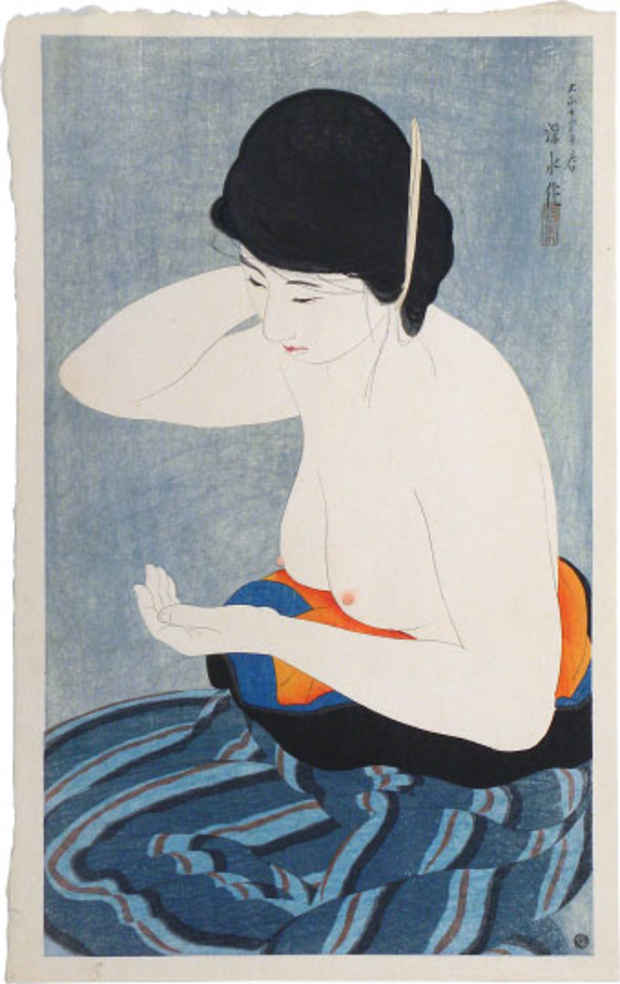“Uncovered and Discovered: The Nude Figure in Modern Japanese Prints” Exhibition
Scholten Japanese Art

This event has ended.
This presentation is devoted to exploring the Japanese response to the classical Western concept idealizing the nude figure in a work of art.
Although depictions of idealized beauties (or bijin) were one of the primary subjects of ukiyo-e (lit. ‘art of the floating world’) for hundreds of years, the completely exposed body as a subject unto itself was rare in pre-modern Japan. Before Japan opened up to Western influence in the late 19th century, depictions of figures were usually highly stylized presentations promoting changing textile designs, kimono fashions and hairstyles. What the figures were wearing and how they were wearing it was more important than capturing the likeness of a person or their body. Even erotic prints and paintings (shunga, lit. ‘spring pictures’) tended to emphasis the removal of clothing in the throes of passion as opposed to the complete absence of clothing. The naked body itself was not necessarily scandalous or even as exciting as the suggestion of an opportunity to reveal a fully-clothed body from beneath gorgeous robes.
However, by the end of the 19th century the rapid modernization of Japan during the Meiji Period (1868-1912) introduced major changes in artistic and cultural sensibilities. Young artist were encouraged to study Western painting and sculpture techniques which emphasized naturalism and realism. Life drawing and nude subjects were introduced along with other Western concepts such as artist as individual creator- a radical departure from the Japanese tradition of the student copying the master. Although government policy equated modernization with Westernization, it wasn’t long before there was some push back against the total abandonment of Japanese techniques. Students of yoga (Western-style painting) who traveled abroad to further their studies would have found a thriving market for traditional Japanese arts, especially woodblock prints.
By the second decade of the 20th century artists and publishers began to consider how to recapture the artistic legacy of ukyio-e without succumbing to the temptation of simply reviving familiar formats and themes. The shin hanga (lit. ‘new print’) genre emerged in response- woodblock prints utilizing Japanese full-color woodblock printing but with a deliberate influence from modern art. What made shin hanga ‘modern’ was often a combination of composition and subject as much as technical developments in the woodblock printing process itself. Prints tended to be lavishly produced utilizing thicker paper and printed in a manner which emphasized the aesthetics of a woodblock print. The hand of the printer was often highlighted- there is no mistaking a shin hanga woodblock print for a mechanical reproduction such as a lithograph. Although most shin hanga prints tended to focus on images that would resonant with a nostalgic views ‘Old Japan’ or the traditional appreciation of the idealized bijin and her accoutrements, some artists explored the modern sensibilities (and the Japanese limits) by depicting bijin as nudes.
An early print by Ito Shinsui (1898-1972), Bathing in Early Summer from the series Twelve Images of Modern Beauties (1922) bears all the hallmarks of a classic shin hanga print in both subject and technique. The composition depicts a kneeling nude gently resting a hand on her shoulder. Her body is defined only by a blind-printed white outline (instead of a typical black outline of a traditional keyblock) rendered in a sketch-like style. Her loosely knotted hair is printed in shades of blue, her lips, cheek and fingers are highlighted with pink. Stylized baren (the tool which forces the ink into the paper fibers) marks decorate the background and swirl over her body to aptly suggest the steam of the bath.
While most prints depicting nude or semi-nude subjects were produced with little response beyond a receptive market, one series published by Ishikawa Toraji (1875-1964) in 1934 caught the attention of the Japanese government who responded by banning the series as a part of a campaign for the National Spiritual Mobilization Movement (Kokumin Seishin sodoin Undo). Apparently the full frontal nudity, bobbed moga (modern girl) haircut and the overtly Western-style furnishings in the Spring Time of Life (1934) were just too modern for the Japanese authorities who were increasingly moving towards a nationalistic agenda by the 1930s.
[Image: Ito Shinsui “Twelve Images of Modern Beauties: Make-up” (1922) , spring, Shinsui) dai oban tate-e 16 x 9 5/8 in.]
Media
Schedule
from September 12, 2013 to September 21, 2013
Artist(s)
Ito Shinsui, Torii Kotondo, Kobayakawa Kiyoshi, Ishikawa Toraji, Onchi Koshiro, Takahashi Hiroaki, Ohira Kasen, Onchi Koshiro et al.